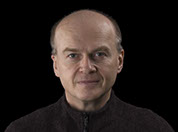

PHILIP BEESLEY
MRAIC OAA RCA, practicing visual artist, architect, and Professor in Architecture at the University of Waterloo and
Professor of Digital Design and Architecture & Urbanism at the European Graduate School.
He serves as the Director for the Living Architecture Systems Group, and as Director for Riverside Architectural Press.
His Toronto-based practice Philip Beesley Architect Inc. operates in partnership with Rolf Seifert and the
Waterloo-based Adaptive Systems Group, and in numerous other collaborations. The studio’s methods incorporate
industrial design, digital prototyping, and mechatronics engineering. Beesley frequently collaborates with artists,
scientists and engineers. Recent projects include a series of hybrid fabrics developed with Atelier Iris van Herpen,
curiosity-based machine learning environments developed with Rob Gorbet and Dana Kulic of the Adaptive Systems
Group, and synthetic metabolisms developed with Rachel Armstrong of the University of Newcastle. His most recent
collaboration with Iris Van Herpen has translated a shared sensibility for subtle materials, electricity, and chemistry into
a collection of highly complex and diverse textile and haute couture collections.
His research focuses on responsive and distributed architectural environments and interactive systems, flexible
lightweight structures integrating kinetic functions, microprocessing, sensor and actuator systems, with particular focus
on digital fabrication methods and sheet-material derivations. Beesley has authored and edited sixteen books and
proceedings, and has appeared on the cover of Artificial Life (MIT), LEONARDO and AD journals. Features include
national CBC news, Vogue, WIRED, and a series of TED talks. His work was selected to represent Canada at the 2010
Venice Biennale for Architecture, and has received distinctions including the Prix de Rome, VIDA 11.0, FEIDAD, Azure
AZ, and Architizer A+.
New Sentient Architecture
Can architecture come alive? Could future buildings think, and care? Researchers from the Living Architecture Systems
Group are exploring these questions by designing new prototypes of experimental architecture. The Living Architecture
collaboration includes architects, engineers and industrial designers from the University of Waterloo in Canada, with
groups of researchers in North America and Europe. Design methods from the Living Architecture group are now being
used to train emerging generations of architects and engineers, providing them with the skills they need to work with
complex interconnected sustainable environments.
These extremely lightweight, flexible structures are interwoven with miniature computers controlling mechanisms that
can sense, react and learn from viewers. The work is organized the same as a coral reef or a swarm of insects, with
large numbers of many individual parts. These systems are connected together, passing signals back and forth so that
the entire environment works as a whole. Interconnected vessels contain a liquid synthetic biology that can absorb and
exchange materials from the atmosphere. Digitally fabricated components make meshwork scaffolds with mechanical
fronds that gently stir the air. Cricket-like acoustic mechanisms make constantly-shifting choruses of whisper sounds,
responding to movement of viewers. Working together, these systems suggest new ways of building adaptive, sensitive
buildings of the future.
Click here for website
The 2018 Atmosphere Symposium is co-chaired by: Lisa Landrum and Liane Veness with the support of the Faculty's Cultural Events Committee and the Centre for Architectural Structure and Technology (C.A.S.T.); web design and graphics support by Tali Budman (ED4 Architecture student), and administrative support from Brandy O’Reilly (Faculty of Architecture, Partners Program).
Questions? Please contact info@atmos.ca
photo: Connery Friesen [ED4 Architecture]
